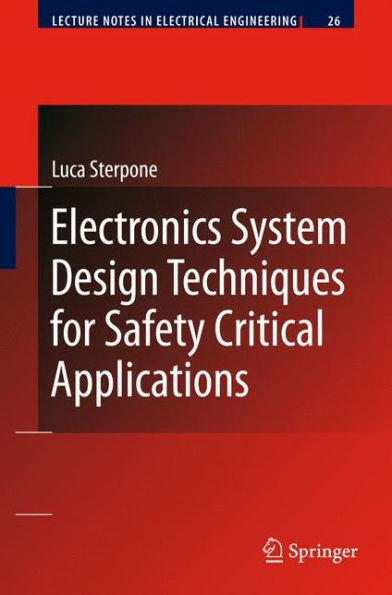Electronics System Design Techniques for Safety Critical Applications
What is exactly “Safety”? A safety system should be defined as a system that will not endanger human life or the environment. A safety-critical system requires utmost care in their specification and design in order to avoid possible errors in their implementation that should result in unexpected system’s behavior during his operating “life”. An inappropriate method could lead to loss of life, and will almost certainly result in financial penalties in the long run, whether because of loss of business or because the imposition of fines. Risks of this kind are usually managed with the methods and tools of the “safety engineering”. A life-critical system is designed to 9 lose less than one life per billion (10 ). Nowadays, computers are used at least an order of magnitude more in safety-critical applications compared to two decades ago. Increasingly electronic devices are being used in applications where their correct operation is vital to ensure the safety of the human life and the environment. These application ranging from the anti-lock braking systems (ABS) in automobiles, to the fly-by-wire aircrafts, to biomedical supports to the human care. Therefore, it is vital that electronic designers be aware of the safety implications of the systems they develop. State of the art electronic systems are increasingly adopting progr- mable devices for electronic applications on earthling system. In particular, the Field Programmable Gate Array (FPGA) devices are becoming very interesting due to their characteristics in terms of performance, dimensions and cost.
1101307594
Electronics System Design Techniques for Safety Critical Applications
What is exactly “Safety”? A safety system should be defined as a system that will not endanger human life or the environment. A safety-critical system requires utmost care in their specification and design in order to avoid possible errors in their implementation that should result in unexpected system’s behavior during his operating “life”. An inappropriate method could lead to loss of life, and will almost certainly result in financial penalties in the long run, whether because of loss of business or because the imposition of fines. Risks of this kind are usually managed with the methods and tools of the “safety engineering”. A life-critical system is designed to 9 lose less than one life per billion (10 ). Nowadays, computers are used at least an order of magnitude more in safety-critical applications compared to two decades ago. Increasingly electronic devices are being used in applications where their correct operation is vital to ensure the safety of the human life and the environment. These application ranging from the anti-lock braking systems (ABS) in automobiles, to the fly-by-wire aircrafts, to biomedical supports to the human care. Therefore, it is vital that electronic designers be aware of the safety implications of the systems they develop. State of the art electronic systems are increasingly adopting progr- mable devices for electronic applications on earthling system. In particular, the Field Programmable Gate Array (FPGA) devices are becoming very interesting due to their characteristics in terms of performance, dimensions and cost.
109.99
In Stock
5
1

Electronics System Design Techniques for Safety Critical Applications
146
Electronics System Design Techniques for Safety Critical Applications
146
109.99
In Stock

Product Details
| ISBN-13: | 9781402089787 |
|---|---|
| Publisher: | Springer Netherlands |
| Publication date: | 10/14/2008 |
| Series: | Lecture Notes in Electrical Engineering , #26 |
| Edition description: | 2009 |
| Pages: | 146 |
| Product dimensions: | 6.40(w) x 9.30(h) x 0.60(d) |
About the Author
From the B&N Reads Blog
